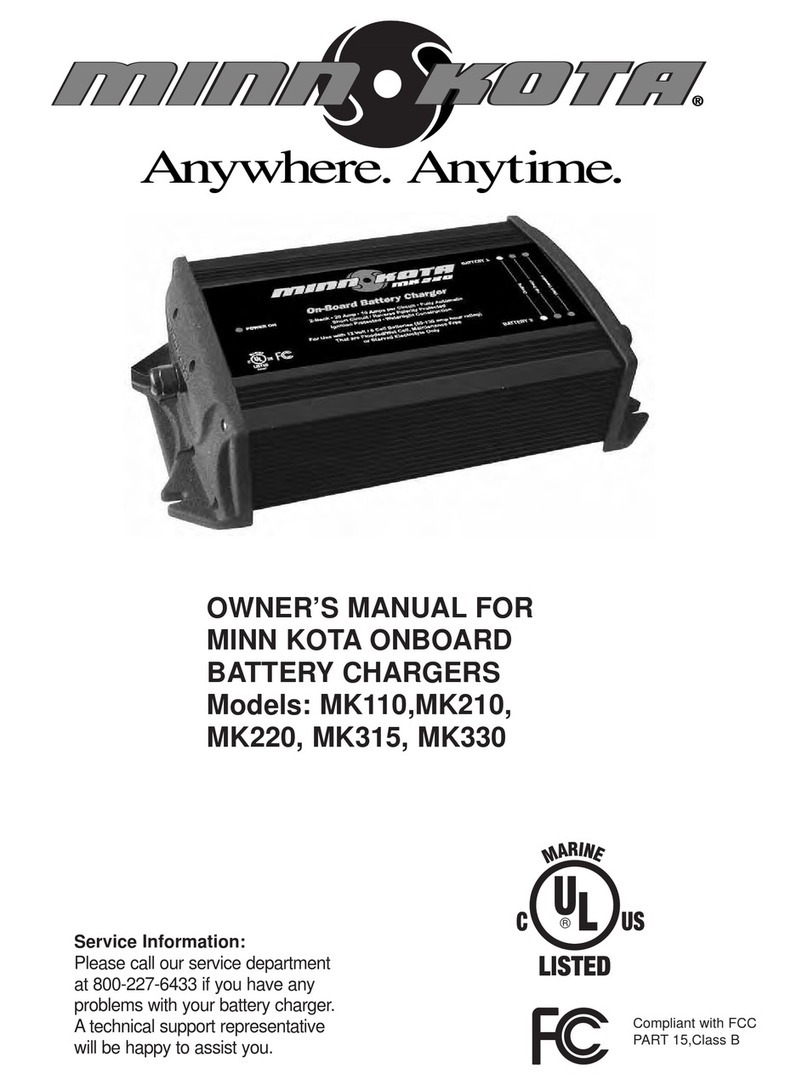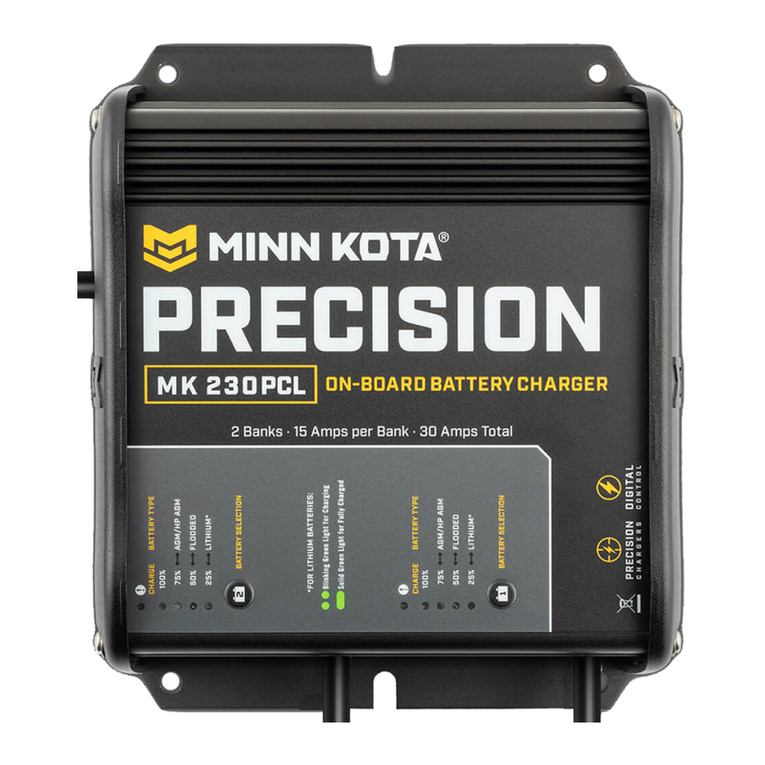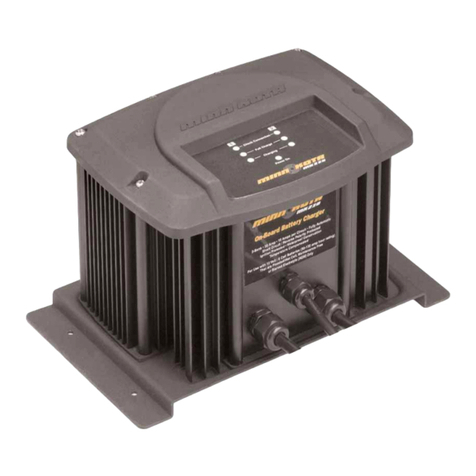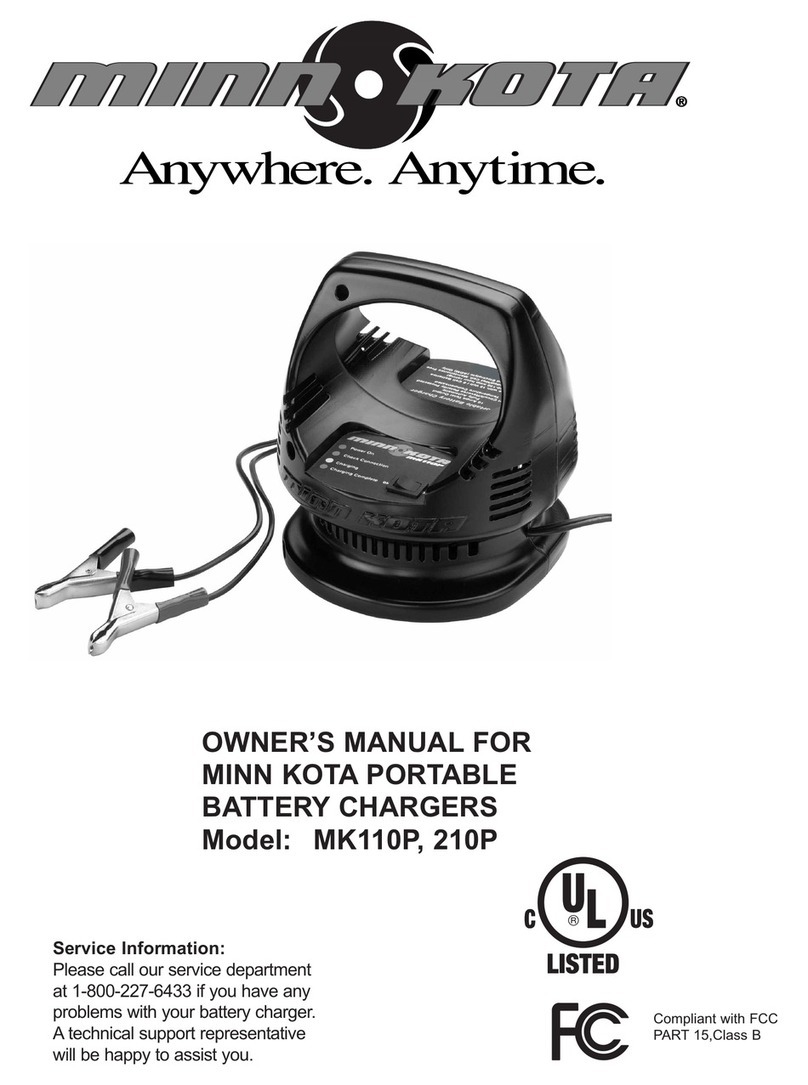MINN KOTA MK-1-DC User manual

OWNER’S MANUAL FOR MINN KOTA
ONBOARD DC ALTERNATOR
BATTERY CHARGERS
Models: MK-1-DC, MK-2-DC, MK-3-DC
Service Information:
Please call our service department
at 800-227-6433 if you have any
problems with your battery charger.
A technical support representative
will be happy to assist you.
Compliant with FCC
PART 15,Class B

2
1. SAFETY INFORMATION
IMPORTANT SAFETY INSTRUCTIONS
SAVE THESE INSTRUCTIONS!
This manual contains important safety and operating instructions applicable to the safe and efficient use of your Minn Kota battery charger.
The Minn Kota battery charger is a powerful electrical device. If incorrectly installed, configured or operated, the battery charger can damage bat-
teries and / or electrical equipment. Please read thoroughly the instructions and safety information contained in this manual before operating the
battery charger.
Use of an attachment not recommended or sold by Johnson Outdoors Inc. may result in risk of fire, electric shock, or injury to persons or property.
The charger is not intended for use by young children or infirm persons without supervision. Young children should be supervised to ensure that they do not play
with the charger.
Do not operate the battery charger with a damaged cord.
Do not operate the battery charger if it has received a sharp blow, been dropped or otherwise damaged in any way.
Do not disassemble the charger. Incorrect reassembly may result in a risk of electric shock or fire.
To reduce the risk of shock or spark, never touch the ring terminals together while the charger is in operation.
External connections to the battery charger shall comply with the United States Coast Guard electrical regulations (33CFR183, Sub Part 1).
2. PERSONAL PRECAUTIONS
Consider having someone close enough nearby to come to your aid when you work near a lead acid battery.
Have plenty of fresh water and soap nearby in case battery acid contacts skin, clothing or eyes.
Wear complete eye protection and clothing protection. Avoid touching eyes while working near battery.
If battery acid contacts skin or clothing, wash immediately with soap and water. If acid enters eye, immediately flood eye with running cold water
for at least 10 minutes and get medical attention immediately.
Never smoke or allow a spark or flame in vicinity of battery, engine, motor or other flammable or explosive equipment.
Be extra cautious to reduce risk of dropping a metal tool onto battery. It might spark or short circuit battery or other electrical part that may cause
explosion.
Remove personal metal items such as rings, bracelets, necklaces, and watches when working with a lead acid battery. A lead acid battery can
produce a short circuit current high enough to weld such items, causing severe burns.
Use the Minn Kota battery charger for charging and maintaining FLOODED / WET CELL, MAINTENANCE FREE, AND AGM / STARVED
ELECTROLYTE batteries only. It is not intended to supply power to low voltage electrical systems other than for charging and maintaining batter-
ies. Do not use the charger for charging dry-cell batteries that are commonly used with home appliances. These batteries may burst and cause
injury to persons and damage to property.
NEVER charge a frozen battery.
WARNING: RISK OF EXPLOSIVE GASES
WORKING IN THE VICINITY OF A LEAD ACID BATTERY IS DANGEROUS. BATTERIES CONTAIN SULFURIC ACID AND PRODUCE
EXPLOSIVE GASES. A BATTERY EXPLOSION COULD RESULT IN LOSS OF EYESIGHT OR SERIOUS BURNS. FOR THIS REASON, IT IS
OF UTMOST IMPORTANCE THAT YOU FOLLOW THE INSTRUCTIONS EACH TIME YOU USE THE CHARGER.
TO REDUCE THE RISK OF BATTERY EXPLOSION, FOLLOW THESE INSTRUCTIONS AND THOSE PUBLISHED BY THE BATTERY
MANUFACTURER FOR ANY EQUIPMENT YOU INTEND TO USE IN THE VICINITY OF THE BATTERY. REVIEW CAUTIONARY MARKINGS
ON THESE PRODUCTS AND ON ENGINE, MOTOR OR OTHER EQUIPMENT REQUIRING BATTERY USAGE.

3. PREPARING TO CHARGE
1) Be sure area around battery is well ventilated while battery is being charged or maintained.
2) Clean battery terminals. Be careful to keep corrosion from coming in contact with eyes.
3) Add distilled water in each cell until battery acid reaches level specified by battery manufacturer ONLY AFTER the battery has been charged.
Adding water to a discharged battery may result in acid leaking out of the battery and causing injury to persons and damage to property. Do not
overfill. Study all battery manufacturers’ specific precautions; however, make sure to REPLACE ALL CELL CAPS after refilling so that water
evaporation is avoided. Water will evaporate over time if cell caps are not replaced after refilling. For a battery without removable cell caps,
such as valve regulated lead acid batteries, carefully follow manufacturer’s recharging instructions.
NOTE: The battery fluid level should be checked every 30 days
4) Study all battery manufacturers’ specific precautions while charging and recommended rates of charge.
4. DC CONNECTION PRECAUTIONS
1) The Minn Kota charger will only charge 12 volt 6 cell lead acid batteries. Do not connect the output of the charger to any other voltage or
type of battery.
2) The charger’s terminals are designed to be permanently mounted and connected to batteries.
3) The charger output leads must be connected with the correct polarity for the charger to function. The RED lead must be connected to the
POSITIVE terminal of the battery and the BLACK lead must be connected to the NEGATIVE terminal of the battery. See section 5 under
“CONNECTING THE BATTERIES TO THE CHARGER” for proper connection procedure.
5. INSTALLING THE BATTERY CHARGER
CHARGING REQUIREMENTS:
In order to achive full output from the DC Alternator Charger, the minimum input from the engine alternator must be as follows:
MK-1-DC: 12 amp minimum
MK-2-DC: 25 amp minimum
MK-3-DC: 35 amp minimum
CHOOSING THE MOUNTING LOCATION:
Do not mount the charger above batteries as lead-acid batteries give off corrosive gasses which will damage the charger over time. Never allow
battery acid to drip on charger when reading electrolyte specific gravity or filling battery. Also, as with most electrical devices, do not mount the
charger below the waterline of the boat or directly adjacent to fuel tanks.
Each DC input and output cord is 6 feet long. Make sure that all DC cords can reach the batteries.
If the DC battery leads are not long enough, they should be brought to a terminal block and extended from the terminal block with 12 AWG (min-
imum) wire. A fuse holder should always remain within 7 inches of the battery terminals. The maximum extension length is 15 feet. You may
contact the Minn Kota Service Department with any questions.
Even though the Minn Kota charger is capable of operating in a high ambient temperature environment, a minimum of 6 inches of unobstructed
area should be allowed on all sides of the unit for proper air circulation and cooling. Proper cooling and circulation will allow the charger to oper-
ate at peak efficiency.
MOUNTING THE CHARGER:
Due to the pounding that boats routinely endure, take the time to securely mount the charger to prevent damage. Mounting with bolts, nuts, and
washers is preferable to mounting with screws. Use the largest diameter bolts possible, and use all four mounting holes.
CONNECTING THE BATTERIES TO THE CHARGER:
1. Find the input cable labeled “STARTING” and connect POSITIVE (RED) wire to POSITIVE (+) or ungrounded terminal on the starting battery.
Then connect the NEGATIVE (BLACK) to the NEGATIVE (-) or grounded battery terminal on that battery.
2. Find each output cable and connect POSITIVE (RED) wire to POSITIVE (+) or ungrounded terminal on the trolling battery. Then connect the
NEGATIVE (BLACK) to the NEGATIVE (-) or grounded battery terminal on that battery.
3. Connect additional output cables to additional batteries as described in step 2.
3
CAUTION - Before making any connections to batteries in a confined space (such as a battery compartment of a boat), open the door or hatch
of the compartment and allow it to air out for 15 minutes. This allows any gasses that have accumulated in the compartment to escape.

4. For this DC Alternator Charger to function, find the purple ignition wire and connect it to the
Ignition Circuit. This can be any +12v source that is only energized when the ignition key is turned
on. Use the quick connect terminal provided. See diagram to the right. If the purple ignition wire is
not long enough, it can be extended with 18 AWG wire.
Each output bank is independent and isolated from one another. The Minn Kota charger can charge
independent batteries or combinations of batteries hooked in series or parallel without disconnecting
the batteries from any switches or wires / straps joining the batteries. See diagram on page 6.
6. OPERATING INSTRUCTIONS
Make sure the charger is properly mounted and the cords are connected properly to the batteries.
Double check the polarities of the cords and make sure the correct bank of the charger is connected
to the correct battery
INDICATOR LIGHTS:
The following will be displayed on the charger:
1) A GREEN power light is lit to indicate the ignition is turned on.
2) A RED power light is lit to indicate the input cord to the starting battery is connected reverse polarity.
3) A YELLOW light is lit to indicate the trolling battery(s) is(are) charging. (The starting battery voltage must be above 13.6V for the
charger to operate.)
4) A RED light for each output is lit if any battery(s) is(are) connected reverse polarity
INLINE FUSE:
Each input and output cord has inline fuses on the leads located near the ring terminals. These fuses serve as protection from surges and short
circuits caused by a damaged charger output cable. If a fuse blows, replace it with the exact type and rating of the original fuse. Improper bat-
tery connections will normally not cause a fuse to blow since this is handled by the chargers internal circuitry.
7. MAINTENANCE / CLEANING / STORAGE INSTRUCTIONS
Check battery charger for dirt, oil, battery corrosion, etc. Use a water and baking soda solution for cleaning corrosion. Wipe clean using a dry
cloth.
Check ring terminals for dirt, oil, and battery corrosion; then disconnect from battery posts and clean as necessary with water and baking soda
solution and dry with a clean cloth.
4
CAUTION – If a RED light is lit, disconnect the input cord from the charger immediately. Determine the reason based on the above information
and take the necessary corrective action to remedy the situation. If you are unable to remedy the situation and need help, call the Minn Kota
Service Department at 1-800-227-6433 and a technical support representative will be happy to assist you.
CAUTION – Changes or modifications not expressly approved by the party responsible for compliance could void the user’s authority to oper-
ate the equipment.
NOTE – This equipment has been tested and found to comply with the limits for a Class B digital device, pursuant to part 15 of the FCC Rules.
These limits are designed to provide reasonable protection against harmful interference in a residential installation. This equipment generates,
uses and can radiate radio frequency energy and, if not installed and used in accordance with the instructions, may cause harmful interference
to radio communications. However, there is no guarantee that interference will not occur in a particular installation. If this equipment does
cause harmful interference to radio or television reception, which can be determined by turning the equipment off and on, the user is encour-
aged to try to correct the interference by one or more of the following measures:
Reorient or relocate the receiving antenna.
Increase the separation between the equipment and receiver.
Consult the dealer or an experienced radio/TV technician for help.
Specifications:
Model Part No. System Volts Banks Input Cable
Output
Cable Size L x W x H
Weight
(lbs)
MK-1-DC 1821031 12 114AWG - 6’ 16AWG - 6’ 7” x 7-1/4” x 3-1/2” 5
MK-2-DC 1821032 12 / 24 212AWG - 6’ 16AWG - 6’ 10-1/2” x 7-1/4” x 3-1/2” 6.5
MK-3-DC 1821033 12 / 24 / 36 312AWG - 6’ 16AWG - 6’ 14-1/4” x 7-1/4” x 3-1/2” 8.5
Ignition
Circuit
I
SB
Purple wire
Solenoid Battery

5
8. TROUBLESHOOTING
PROBLEM:
Check Alternator Connection (Red) light comes on.
SOLUTION:
-Check polarity of leads to starting battery.
-If still not working, call the Minn Kota Service Department at 1-800-227-6433.
PROBLEM:
Check Connection light comes on for output cables.
SOLUTION:
-Check polarity of leads to trolling batteries.
-If still not working, call the Minn Kota Service Department at 1-800-227-6433.
PROBLEM:
Indicator lights are not illuminated when the engine is operating.
SOLUTION:
-Make sure all terminals are tight and have the correct polarity.
-Make sure the purple wire is connected to a +12v ignition source. See page 4.
-Check fuses in the fuse holders to the starting battery.
-If still not working, call the Minn Kota Service Department at 1-800-227-6433.
PROBLEM:
Charging Trolling Batteries light is not illuminated when the engine is operating.
SOLUTION:
-Make sure the engine alternator size is adequate to allow the DC Alternator Charger to operate properly. See page 3.
-Make sure all terminals are tight and have the correct polarity.
-Make sure the purple wire is connected to a +12v ignition source. See page 4.
-Check fuses in all fuse holders to the starting and trolling batteries.
-Check starting battery voltage. (Starting battery voltage must be above 13.6V for the charger to operate)
-If still not working, call the Minn Kota Service Department at 1-800-227-6433.
INDICATOR LIGHTS
This manual suits for next models
2
Table of contents
Other MINN KOTA Batteries Charger manuals
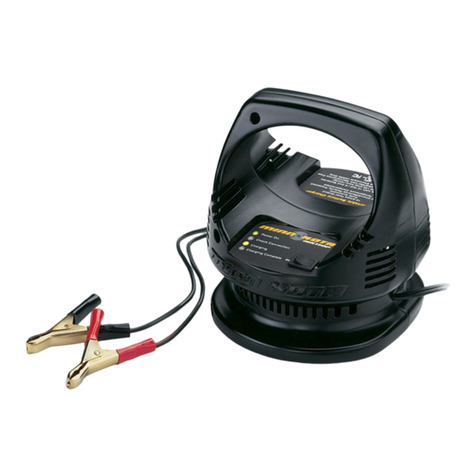
MINN KOTA
MINN KOTA 210P User manual
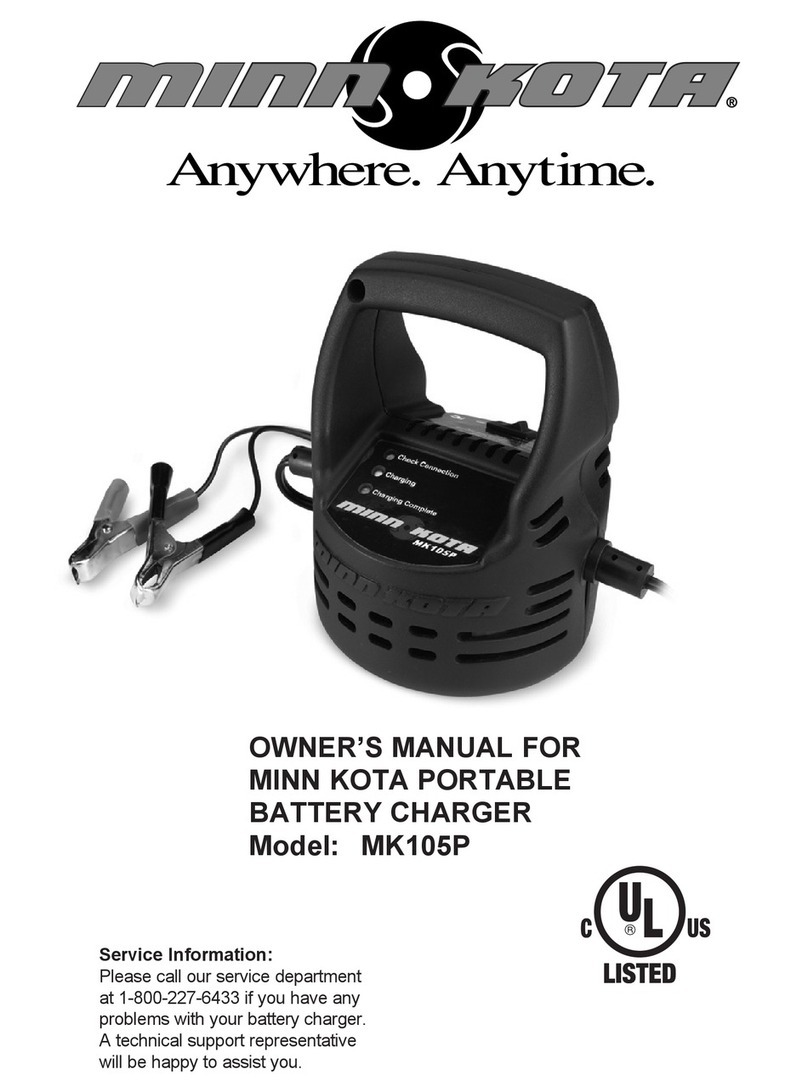
MINN KOTA
MINN KOTA MK105P User manual
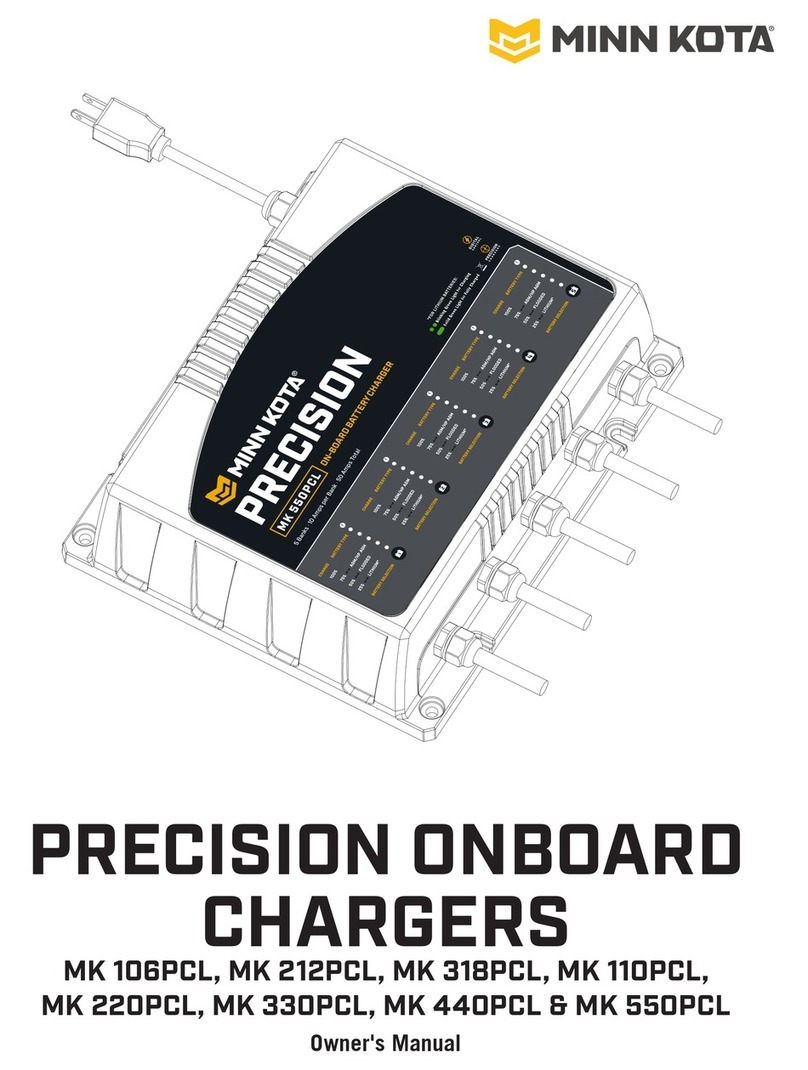
MINN KOTA
MINN KOTA PRECISION MK 106PCL User manual
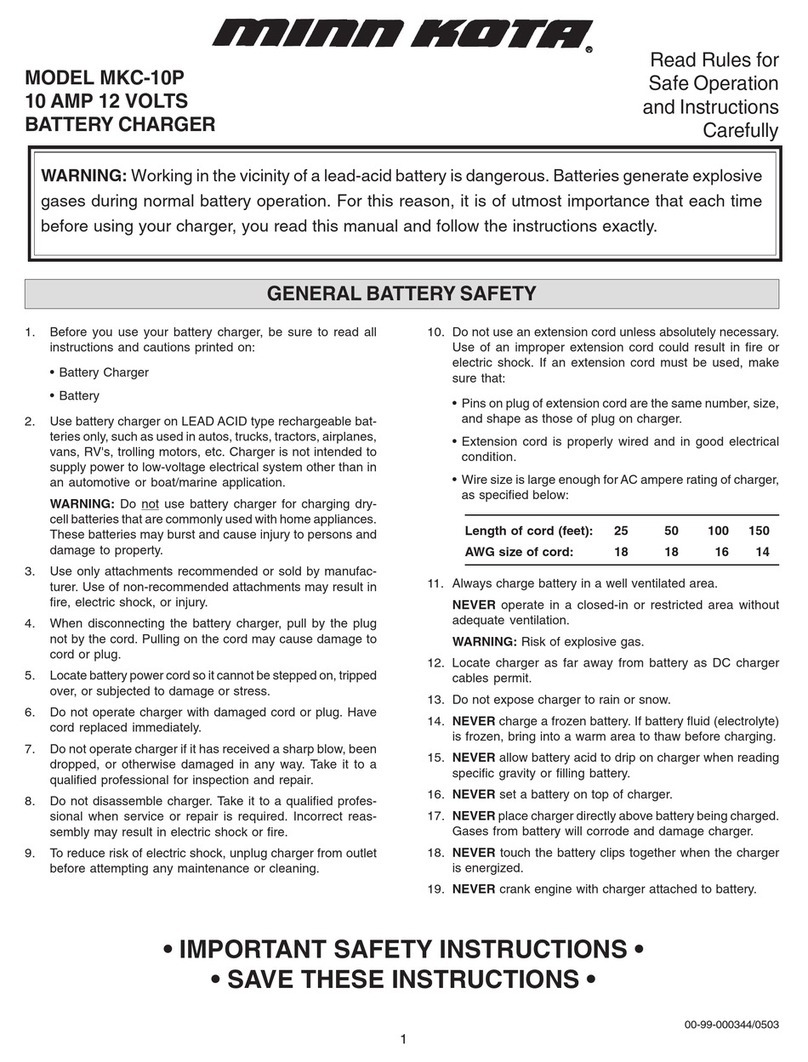
MINN KOTA
MINN KOTA MKC-10P User manual
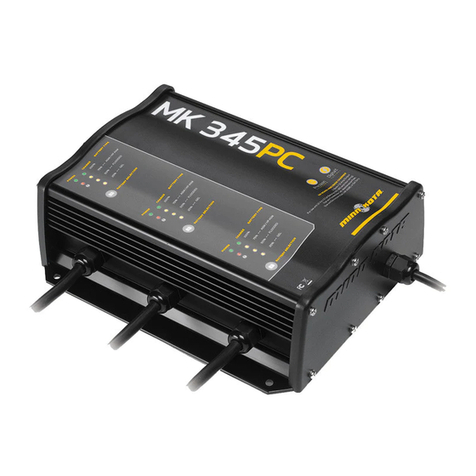
MINN KOTA
MINN KOTA MK115PC User manual

MINN KOTA
MINN KOTA MK105P User manual

MINN KOTA
MINN KOTA MK106PC User manual
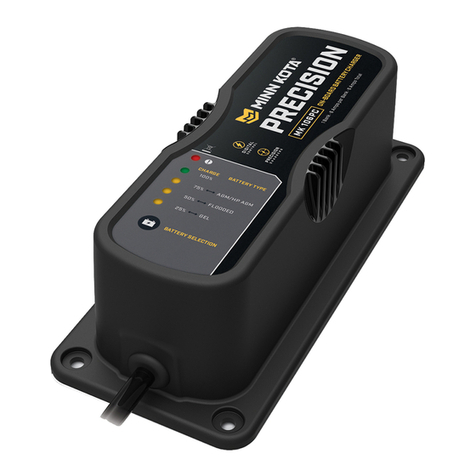
MINN KOTA
MINN KOTA MK106PC User manual
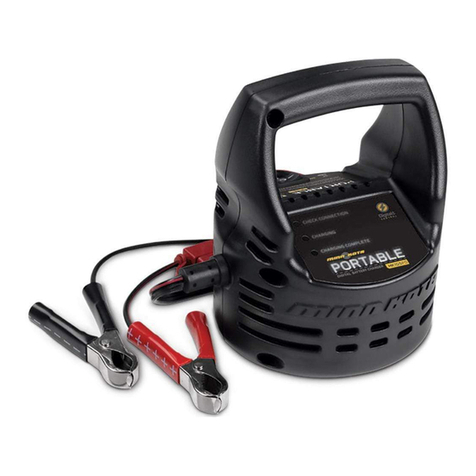
MINN KOTA
MINN KOTA MK-105PD User manual
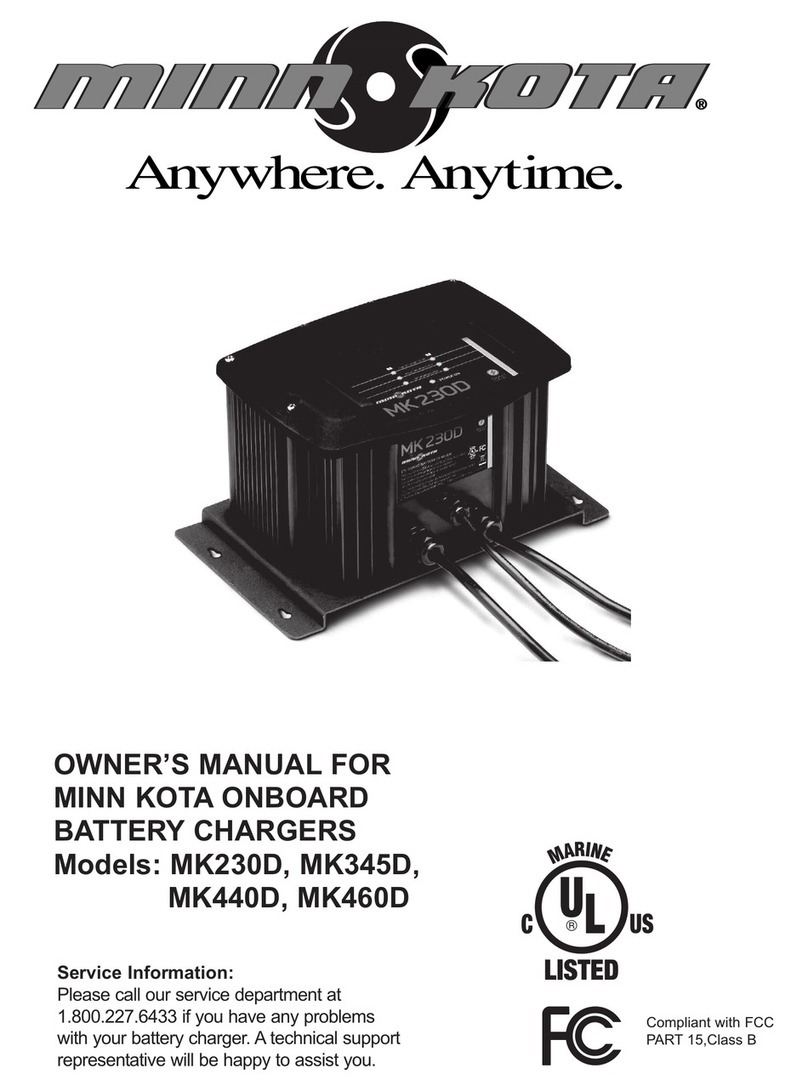
MINN KOTA
MINN KOTA MK230D User manual

